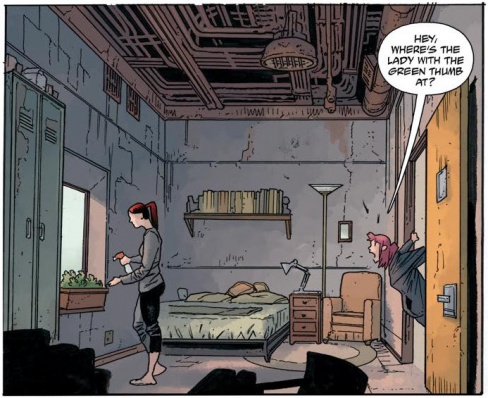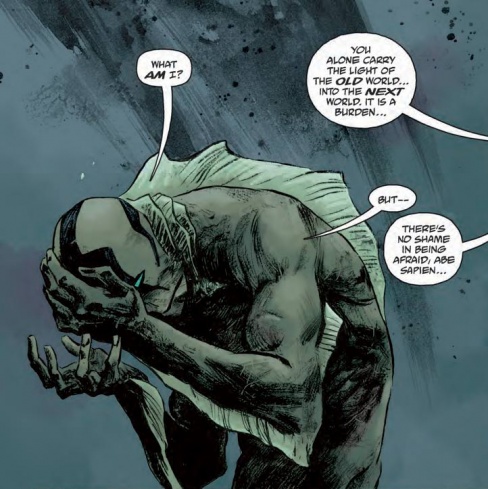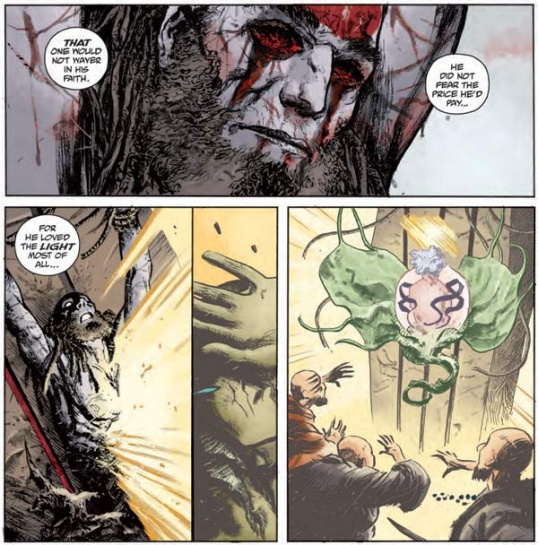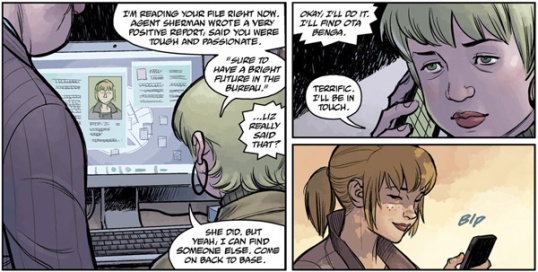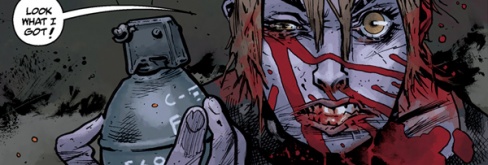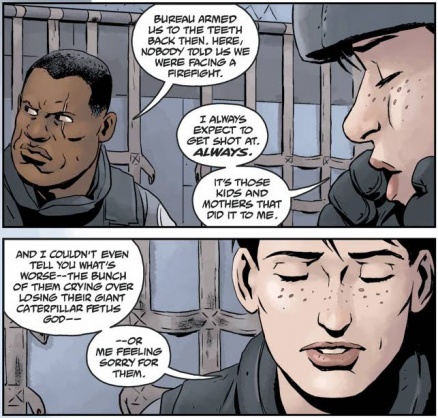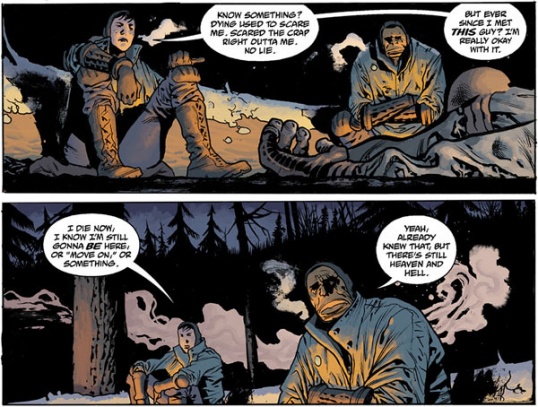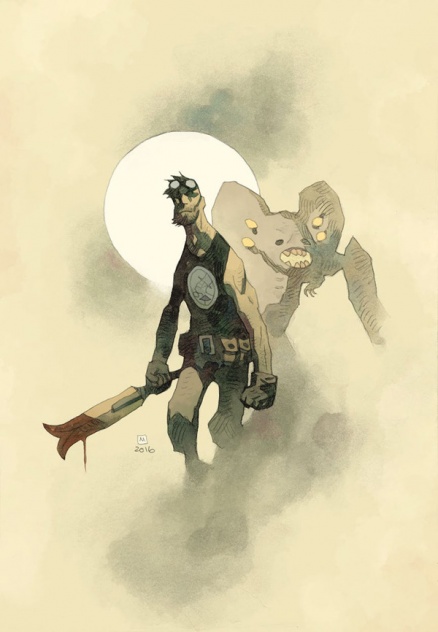
Welcome to Hell Notes, Multiversity Comics’ annotation column for the Hellboy Universe. New week “B.P.R.D.” returns. We’ve had the “Plague of Frogs” cycle and the “Hell on Earth” cycle, now we’re launching into the final cycle, “The Devil You Know.” However, before we take that plunge, I wanted to reacquaint readers with the cast. That’s a huge task, so we’re doing something a little different with this Hell Notes. To help me out, Scott Allie, co-writer of “B.P.R.D. The Devil You Know ” is pitching in.
Andrew Devon
B.P.R.D. Field Director
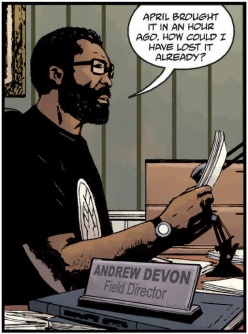
Honestly, that’s a bit of a surprise. When Devon first joined the Bureau in 2006 in the wake of the Katha-Hem incident, he was a bookish guy in way over his head. I think it’s fair to say that over the last decade he’s undergone a substantial transformation.
Scott Allie: The Bureau wasn’t the best career choice for Devon. He’s turned out a completely different guy than the one we met in “The Universal Machine.” But from that first story, Kate was his model B.P.R.D. agent—they had the most in common in terms of background—and then she wound up running things. It was natural for him to follow in her footsteps. But the things that made Kate a great leader were not the things she had in common with Devon. She struggled with the job, and Devon’s struggle is worse.
Mark: I agree. Kate managed the job a lot better than most and it broke her near the end. Meanwhile, Devon has cracked under far less strain and he’s inclined to let fear affect his judgment. That said, he’s no coward either―he’s always stood his ground, even when he’s utterly terrified.
Scott: Writing Abe’s series, I developed a fair amount of antipathy for Devon, only viewing him in terms of the role he played in Abe’s recent troubles. I had to find a more charitable view of him in “The Devil You Know.”
Mark: I’m pretty sure a lot of fans nurse a grudge against Devon too…
Elizabeth Sherman
B.P.R.D. Field Agent

The Liz in the latter half of the “Hell on Earth” cycle was a Liz unfettered. She had control of her powers and she had confidence at last. She’s emerged as one of the most physically formidable individuals in the series, able to take down Ogdru Hem single handedly.
Scott: “Lake of Fire” was a while ago… From there, Liz embraced her role in a way she never had before, as you say. We won’t tell a “Dark Phoenix” story, but we’ll see the uncomfortable ways that she wears her role. Liz is in the best shape she’s ever been, the most actualized and comfortable in her own skin. But she’s lost pretty much everyone important to her. Early in the new series, she has a falling out with one of her few friends left at the end of “Hell on Earth.” But Liz is the greatest hero the Bureau has right now, not just in terms of power, but as a character. I’m excited to see her at this stage in her life.
Continued belowMark: When I think of “Plague of Frogs,” I think of it as the family cycle of “B.P.R.D.”―it’s when the team was tight-knit. “Hell on Earth” was the broken family cycle, with the group falling apart, barely holding together. In “Hell on Earth” characters usually faced their problems alone, but in “Plague of Frogs” the characters invested in each other’s problems unconditionally. Kate was there for Liz, Daimio was there for Abe.
I feel like this is Hellboy’s legacy at the Bureau. He made the Bureau a home for Liz, Abe, and Roger. And if there’s anyone left that still understands this, it’s Liz. You could see it in the way she interacted with Fenix. And she’s broken so many times, she knows the value of having a friend as support.
Scott: Well, Liz is the original runaway (not counting Hellboy splitting for “The Midnight Circus”). Liz ran away from the Bureau as a kid, and again in “Hell on Earth.” “The Devil You Know” finds her longing for some of the family you refer to. When I was writing the “Abe Sapien” series, I realized a lot of my favorite long form stories are about the families people create, like Walt and Jesse in Breaking Bad, or Vic Mackey’s crew in The Shield—and here I was writing a book with a character utterly alone, forming single-serving friendships along the way. The “Dark and Terrible” story couldn’t have been told in the team setting, but there’s so much I could have got out of Abe by having Liz or Roger or Kate there.
Abraham Sapien

The last we saw of him, he’d been found by the Bureau and was being brought to their new headquarters.
Scott: Abe found some clarity in “Dark and Terrible.” He’s no longer running from the truth, but there are still some truths to discover. He’ll keep growing and moving forward. But given what he knows, he has tough decisions about his role in the Bureau. Besides the truths about himself, a lot of “Dark and Terrible” was about him wrestling with the idea of violence, or being a soldier. In the final issue, he fought Strobl with everything he had, but that doesn’t mean he’s going full Daimio. He and Liz are in very different places as far as that goes.
Mark: I also find Abe is really in the opposite place to Liz in that he’s still got a lot of self-loathing to deal with, and he has been very stubborn about dealing with things alone. It reminds me how important it was that he had Daimio during “Plague of Frogs.” He has so much to deal with when he gets back, the loss of so many friends. Even if he returns to the Bureau, I feel he’s more alone than he’s ever been before.
Scott: Abe dealt with a lot in his series, and now he’s going to learn a lot of what’s happened while he was away. Something I encountered editing “Buffy,” years ago, is that it’s a tricky thing having a character deal with information that’s old news to the readers. If we spent an issue on Abe dealing with Kate’s death, readers might say, ‘Enough already, we know this.’ But Abe’s reaction to that is something readers are interested in. So it’s a balancing act. The trick is looking at those revelations in ways that move the story forward rather than just looking back. Abe often had no one to talk to in “Dark and Terrible,” or at least no one with whom he could be uncensored—no old family, so to speak. To reunite Liz and Abe now would offer a lot of opportunity for soul bearing. For both of them.
Continued belowMark: In “Dark and Terrible” Abe had finally reconciled (well, mostly) with his former life as Langdon Everett Caul, but now he’s got another past life to take into account, a life as a T’shethuan shaman. Unlike Caul, this isn’t a life he needs to be ashamed of though―as a shaman, he had been a noble figure. I find this past life rather exciting, as it represents a spark of real hope in Abe. He has the potential to be something wonderful when for so long he only saw himself as a force of destruction.
Scott: A big question of “Dark and Terrible” had to do with what Abe really owed Caul. He was told more than once that he’s not Caul, but I imagine some readers don’t accept that—your point suggests you don’t accept it, and that’s valid. It’s a question the story poses, not one that it answers. So the question of what he owes the other shaman is a big one too. And we’re not talking about Shonchin, but the shaman Abe bears a connection to. I forget his name. It’s in the scripts, but I left it out of the comic, so no one knows it but the team from the book.
Shonchin
T’shethuan Shaman
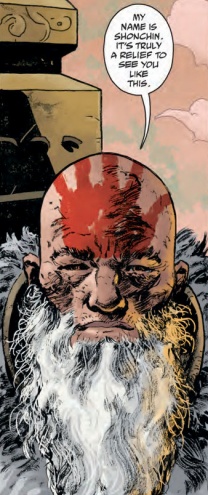
Scott: He’s served significant purposes in the course of the story so far, and it’ll be interesting for the careful reader, as the conflict of “The Devil You Know” becomes clear, to consider Shonchin’s role in it. With John and Mike as writers on these books, they had complementary ways of looking at characters. Mike sees the mythic roles in his main characters and helps to find the mythic through lines of the ones that were developed with collaborators. John has a personal, human approach to characters, and usually, put the mythic role of the character to the backseat a lot of the time. Because of the story we’re telling in “The Devil You Know,” the mythic roles are in the foreground again. I love the human drama that John is so good at, but I’m also really comfortable throwing myself into the mythic aspects of the characters, looking at the characters for the archetypes they serve. So their roles, as I look at them, are very personal, in how they relate to their friends, and also mythic, in the purpose they serve in the Mignolaverse.
Johann had his personal story and his mythic story resolved when he killed that Ogdru Jahad and embraced the changes that came over him. Hellboy served his mythic function in resolving Hell while finding personal peace in that house there. Abe and Liz are in different places emotionally, but they’re both poised to face their destiny. They’ve come a long way from “Seed of Destruction,” and it’s exciting to be standing here with it all about to break.
Ted Howards / Gall Dennar
B.P.R.D. Field Agent / Prehistoric warrior

One thing I’ve really enjoyed with him is the way his story can bridge two eras, and as it becomes more and more clear that the past is important to the future, he’s a character whose role I can see becoming more and more important.

Mark: One thing that’s never really been established, though it’s been hinted at, is the exact nature of Howards and Gall’s connection. Personally, I don’t even really separate the two characters. They feel like the same character in two times, sharing memories.
Scott: That’s wide open to interpretation. I can’t think what kind of scene would come up that would make it clear. Is that something you think the story would address? What could you imagine happening that would either prove that they really are one person, or that maybe Howards only inherited some memories through the sword?
Mark: It’s not actually something I thought the story would address, no. There’s a moment in “Lake of Fire” when Howards remembers Gall fighting against the pre historic vampires. And then we push in on Gall while he’s fighting, and it his mind’s eye he’s seeing Howards eating in the Bureau cafeteria. The two were still connected. A scene like this is enough for me to say, ‘Oh, Gall-Howards is living both lives in tandem.’ That felt like all I needed.
However, I guess my assumption is that it’s a one for one trade off. For example, if it has been a year since Howards found the sword, then he remembers/experienced a year of Gall’s life since they got the sword―but he wouldn’t remember Gall’s death (and Gall wouldn’t remember Howards’s death) because they haven’t lived it yet. I assume the live their lives in two parallel moments in time.
The question is how those lives affect each other. In “Flesh and Stone” we saw Gall learn to use shamanic stones, but it was Howards that put that knowledge to use in the present. It was passively gained information in that case, but perhaps it can be actively pursued too. If, for example, the Bureau needed information about Hecate, could this perhaps set Gall on a mission after the Black Heccata cult?
Scott: It’s kind of like with Abe. Does Abe remember all of Caul’s life, or only what we’ve seen him think about? There’s a line addressing this in “Dark and Terrible,” but I consider it open to the reader’s interpretation. Leaving this stuff open to your interpretation allows us to make decisions about it later. If John and Mike and I had had a call when I was writing “Abyss of Time,” and said, ‘Okay, what are the rules on how this works?’ we could have nailed it down right there. But if at some point during the writing of “The Devil You Know” I realize, ‘Wait, for this story beat to work, Howards can’t know how Gall Dennar died’ … well, I have room to establish that.
Continued belowHow Gall Dennar and Howards affect each other is up for grabs to a degree. The issue #3 cut away to Gall Dennar explains Howards’s perspective on the chaos in the world, how different all this looks to Howards than it does to Liz. Is he Gall, or does he just have the benefit of Gall’s experience? It might never be so tight, as specific as the Black Heccata example you give… but that could happen. The story I did with Tim Sale in the Christmas Special a couple years ago, “Broken Vessels,” that was valuable info for Howards, but it doesn’t quite serve out in the way you suggest… not that helpful.
Mark: I think scenes that create context, rather than give explanations, end up being much more interesting anyway. Plus it gives readers room to invent their own explanations.
Scott: Exactly! A couple weeks ago Katii [O’Brien, assistant editor] and I and a couple other people at Dark Horse were talking endlessly about the film It Comes at Night, which leaves so much room for the reader to work out the details, to engage actively. Readers don’t want to have it all explained. They think they do, they even get frustrated if it’s not, but if it is all spelled out, they cease to engage.
Mark: I still wonder how Gall’s sword got from America to Africa. I imagine he or one of his ancestors went into the Hollow Earth at some point. That whole pre history world seems like it’d be fun to explore outside of the confines of “B.P.R.D.” someday.
Scott: There’s a flippant comment I throw out, about things like that. It’s an anecdote, probably apocryphal, about Shakespeare. Someone suggests there’s a plot hole in one of his plays, and he says, ‘If I thought it was important, I could have come up with something, as I am, after all, Shakespeare.’ The question is, when is that non-answer valid? Because if something fails to make sense, if it pulls the reader out, that answer is bullshit. We don’t know how many tens of thousands of years ago Gall Dennar lived, but certainly in the time since something could have moved the weapon—and if it becomes pertinent to our story, we’ll tell you.
Ashley Strode
B.P.R.D. Field Agent and Exorcist
Mark: The Bureau has kind of being amassing agents with special abilities for a while now. Obviously, there are people like Liz and Abe, but then there’re people like Howards who started off just a regular guy and became something else. Another character like that is the exorcist-in-training Ashley Strode. Given the state of the world now, I can imagine her abilities will be very useful going forward.
Scott: Ashley was developed because we wanted Cameron Stewart to have someone to play with. She served her purpose in the “War on Frogs” story with Liz, but we might have never gone back to her except Cameron wanted to do a certain kind of thing with a certain kind of agent, and Ashley was just sitting there with nothing to do. By the time Cameron was putting together his follow-up three-parter a couple years back, Mike and I had determined that we wanted her in the final cycle. I had to renege on my offer to Cameron that he could do whatever he wanted to with her, have her die in the story if he wanted. He wasn’t going to do that, though. But she’ll have a good place in the new cycle.
Mark: Ash is also notable because she’s the first openly gay character in the series. She even has a bit of a crush on Liz. This is interesting because when you stop and think about it, we don’t often explore this aspect of the agents in the Bureau. We see them at work, so we see them through a narrow lens to a degree. Liz has been in the series since the beginning, but I don’t know anything about her sexual orientation. And the same can be said for many others. Hellboy, Kate, Johann are rare exceptions in this regard, and exploring this aspect of their characters led to deeply personal moments.
Continued belowScott: Mike’s stories have seldom been about romantic relationships. I don’t remember what John’s intention with Ashley was when he first introduced her ‘crush’ on Liz, but it was Cameron who made it a more evident aspect of her character. Hellboy himself had a couple relationships in his lifetime, we saw one with Kate and the German cop Bruno. In planning out “The Devil You Know,” one romantic relationship came up as something Mike and I wanted to do. It surprised us. But it’s still just not what these stories are about. When writing and editing “Buffy the Vampire Slayer,” the romantic inclinations of the characters were in the forefront. Writing “B.P.R.D.,” knowing where a character’s heart might lead her, you have to look at how relevant that is to the story, to what they’re doing. These are, after all, people at work.
The B.P.R.D. Grunts
B.P.R.D. Field Agents
Mark: “Hell on Earth” expanded the focus of its cast from the Enhanced Talents Taskforce to include several regular agents of the Bureau. With so many casualties in the wake of “Hell on Earth,” perhaps not all will make it into “The Devil You Know.”
Scott: Some will, some won’t, for various reasons.
Carla Giarocco
Mark: Carla made her initial appearance as a corpse in Liz’s vision in “King of Fear” at the end of the “Plague of Frogs” cycle. Since then we’ve learned she’s a mother and an absolute badass. She’s also perhaps the most competent field agent of the regular human agents we got to know over the course of “Hell on Earth.” She also worked with the Russian Bureau, the Special Sciences Service (S.S.S.), more closely than any other agent and had an excellent rapport with the former Director Iosif Nichayko.
Scott: Ah, that’s assuming that that corpse in “King of Fear” was Carla… Actually, I can tell you that that was John throwing out a little possible story thread that didn’t work out as planned. That was supposed to be Carla’s son grown up. Well, we should all live so long. Plans change a lot, though. Some of the human grunt characters that are introduced have a higher purpose, a key role in where things are going, and some don’t—and some purposes change. There were some things Mike and I thought up for the human characters for “The Devil You Know” that isn’t going to have room. There’s enough going on with the main characters that not everyone will have the arcs they might have.
Agent Nichols and Rebecca Gervesh

Scott: That’s an interesting contrast, and sounds right to me. Nichols has been one of my favorite regular characters. John didn’t always have a bigger mythic purpose to his characters because he’s so naturalistic in his writing of human beings. So some of these characters will seem to be forgotten in “The Devil You Know,” if only because I don’t have a great purpose for them to serve, and don’t want to clog the book up making sure everyone gets screen time. I understand the impulse to do that. I lived through it on Buffy, where every single character had their passionate advocates among the fans, where people got mad if a minor character didn’t get their due. We capitulated maybe more than we should have. But we might have to live without some of our familiar faces if we don’t have good things for them to do…
Mark: Yes, they’re what I like to call flavor characters—it’s unlikely they’ll ever be big players in this story, but they’re important reminders of what the world looks like from the point of view of a person that only sees the small picture. Their world is full of weird stuff, but they don’t sit back and go, ‘Ah, yes, that’s Vril, the same power once wielded by the ancient Hyperboreans.’ Sometimes it’s important to remember the small picture because it truly gives scale to the large.
Continued belowScott: I love that aspect of it. It’s a very important part of the book. One of the purposes of “Dark and Terrible” was to give a ground view of the end of the world. And the grunts have a different perspective on things than Liz or Kate. But so too does the average schlub—the barista in, what was it, Santa Fe, in that one-shot John and Tyler did, my single favorite issue of “Hell on Earth.” That’s also one of the best examples of our creative chemistry—and I can say that because I played almost no role in it. Mike rolled out the idea of a barista in Seattle stressing out because the coffee beans weren’t showing up because an Ogdru Hem had taken out a highway. There was more to it than that. And I said, ‘That’s a great John Arcudi story!’ Even though Mike had the initial idea. But it was a great Arcudi story, so thank god he was available. And it also seemed like a perfect Tyler Crook story, at a time when he was stepping away from the parts of “B.P.R.D.” that weren’t so perfectly Tyler Crook. Same thing happens in “The Devil You Know,” Mike pitching me an image he describes as a very Scott Allie kind of moment. Good thing Mike told me to put it in there, so my fingerprints are evident on the pages…
So meeting new characters and seeing how they react to things is valuable. I love that. But after a while, Gervesh isn’t the fresh eyes of the reader, and then we throw a new pair of fresh eyes in. I can think of a scene in the second arc of “Devil You Know” you might read and say, ‘Well, why couldn’t you use Nichols there, instead of introducing a new grunt I don’t care about?’ But the end of the world is a big place, and you wouldn’t keep running into the same people. And you already know how you feel about Nichols, and I wanted you to feel unfamiliar here.
Oh, by the way, I’m gonna make a bold statement here and claim It Comes as Night as a canonical “B.P.R.D.” story. The movie I was talking about before? It was notoriously marketed in a misleading way, so whatever marketing you’ve seen, put it out of your head, go in with no expectations except that I’m recommending it, and say to yourself, ‘This takes place in the fringes of America, one more ugly side effect of the Ogdru Hem, a fact which the characters in the film are unaware.’ It works as a great side story a la “The Pickens County Horror.” Kudos and deep gratitude to Trey Shults.
Mark: Stazz was very much on the periphery of “Hell on Earth,” but she had a much bigger role in “Dark and Terrible.” Most notably, she found Abe, but instead of bringing him back to headquarters as instructed, she let Abe go. Though she only met Abe briefly, she’s proven herself to be an ally.
Scott: She’ll move more center stage. She’s based on my niece, who was a military intelligence officer after a stint in the marines. She helps me out with some details, and I run some dialogue by her for direction. One of my favorite people on earth. I asked her if she had any ideas for how Stazz dies because no one here gets out alive.
Mark: Tian hasn’t been seen much either, but he’s particularly notable in that he’s an old friend of Liz’s, and he became someone Liz could turn to when she needed to talk to and vice versa. With relationships generally going to crap in “Hell on Earth,” Liz and Tian were an island of hope. In “Cometh the Hour,” Tian sharing a cigarette with Liz as they process the death of Panya and Kate ended up being one of my favorite moments.
Scott: Those are the relationships that I got the most out of from John’s approach to “B.P.R.D.” Those are the kinds of relationships I missed when writing Abe, which led me to create Grace and Stazz. The Liz and Tian friendship was a beautiful part of John’s approach.
Continued belowFenix Espejo
Psychic
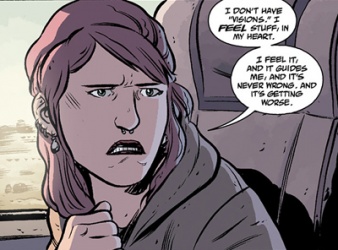
Scott: Actually this would be a perfect place to ask questions, and indeed Fenix will play a part in the book.
Mark: Oh? Well, that changes things, because there are a great many plot threads left hanging with her. So let’s start with the elephant in the room: her visions of Abe.
Scott: Right. In “Hell on Earth,” Fenix was pretty vague about what specifically drove her to shoot Abe. She didn’t have voices saying, ‘Do this.’ She didn’t see clear images of Abe’s actions or the actions of others that she needed to stop or else. Her visions didn’t work like that. She had a sense of things… When she was leading her band of Bedouins, she just sort of got a hunch to go this direction or that, and it would work out. Her ‘decision’ to shoot Abe came about in a similar way. It’ll give people something to talk about in “The Devil You Know.” Both Liz and Fenix have had visions of one kind or another.
Mark: It’s a bit of a cheat to call what Fenix experiences a ‘vision’ really. As you say, it’s a feeling, a precognitive sense. There was a moment in “The Return of the Master” when Panya was teaching Fenix to develop and focus her ability, and Fenix saw this impossible scene of New York in ruins and Abe crucified on spikes. I’ve taken this scene not to be a literal vision but rather a visualization of what Fenix was feeling.
But Fenix’s precognitions are a curious thing, since it may not be her that has the ability, but rather her reabsorbed twin, Eris. Fenix is a genetic chimera after all.
Scott: Well, Fenix had a vision in Texas when she saw those two cops as frog men… that’s how that went down, right?
Mark: Actually, that was a nightmare that the blond guy from Fenix’s crew had.
Scott: Jeez, you’re right. Well, we have little understanding of what pushed Fenix to pull the trigger… apparently less idea than I thought we did. As for the vision of Abe being tortured, I like to think that a guilty conscience drove that vision at least a little bit. But this is one of the things I love about our books, the unreliability of psychic phenomenon. Very early on there was a story in which Mike, or Hellboy, referred to psychics as pains in the ass. As a writer, I feel the same way, because psychics can derail causality and discovery. So the psychics we deal with have opaque abilities. Think of Sue in “Hellboy and the B.P.R.D.: 1954.” She’s started honing her craft, but it remains subject to interpretation.
It can be a tough balance, not making this sort of thing too vague, so that it’s narratively meaningless, but not making it too convenient, so it shortcuts the story too much. We’ve seen a lot of visions in Mike’s books, from those of Fenix to those of Liz to a lot of characters with more sinister wishes. All those visions say similar things, but never use the same words, and feature meaningful discrepancies. Maybe the future really is unwritten, even if the general fate of the world has been written. Hellboy did reject his destiny, and that did change the outcome of things. Some visions won’t come to pass as expected. Memnan Saa didn’t have all the answers, Rasputin didn’t, and Fenix doesn’t—she knows she doesn’t. One of the most interesting questions is about how much Panya really knew. Tough question to address with her dead… As for Fenix’s relationship with her sister, that’s very open to interpretation, like the visions. How distinct an entity is Eris from Fenix herself? It might get answered in “The Devil You Know,” but it may not.
Continued belowMark: The Eris–Fenix relationship is a curious one, but I think it’s complicated by one further detail: Fenix’s Enkeladite necklace. This was an element introduced in “B.P.R.D.: 1948” in a story that introduced the idea of parallel realities to the Hellboy Universe. I’ve no idea what this means just yet, but it seems significant. I like to imagine it’s related to the way Fenix interacts with Eris, and that the precognitions Fenix and Eris get are of a very similar, but different reality.
The Enkeladite is a piece of the puzzle I’ve often wondered about, especially when “The Broken Equation” came out, reinforcing the idea of parallel realities. Of course, in both “The Broken Equation” and “1948,” the realities glimpsed were seemingly very significantly different from our own, to the point that biology on Earth evolved on a vastly different path.

Mark: I’m also curious about what happened to Fenix that made her leave home. The flashbacks we’ve seen show that she had a happy family life, but she ended up a runaway at sixteen. In “Lake of Fire,” we learned that her family had lived by the Salton Sea, so it’s likely they would have seen the emergence of the Salton Sea Monster from “King of Fear.” We also see that her former home is empty.
We’ve seen enough of the world in “Hell on Earth” and “Dark and Terrible” to be able to imagine what happened here, but I wonder if there’s more to it.
Scott: One of the wonderful things about working with John Arcudi is that Mike and I wonder that too… Fenix was his, in more ways than just about any other character. Because John chose to move on, Mike and I get to conclude Fenix’s story, but we won’t step on John’s toes by going back and explaining things he didn’t choose to. And I can see how that could be frustrating, but one never knows what the story will call for down the road.
Mark: In terms of relationships, I like that Fenix was connecting with the B.P.R.D. team. She warmed to Devon early on, and eventually even warmed to Panya, but the relationship that most interests me is the one she has with Liz. Like Fenix, Liz was a runaway and she’s had to deal with her own bouts of precognitions and invisible people talking to her. And yet Liz weathered it and came out the other side much more powerful. For someone like Fenix who is still figuring herself out, Liz is a great person to look up to. And Fenix humanizes Liz too.
But Liz is very close to Abe—they were practically raised as siblings—and Fenix shot Abe. It puts the Fenix–Liz relationship in a somewhat questionable place.
Scott: Yeah, and in “Dark and Terrible,” not too many days went by that Abe didn’t relive the moment when Fee shot him. It’ll probably come up…
James Henry O’Donnell
Consultant to the B.P.R.D.
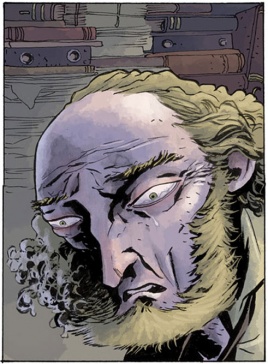
Mark: Honestly, I’d love to pick his brains. He’s been a part of the B.P.R.D. for so long, since the mid-’80s. And while at first he just seemed like a very eccentric (if oddly convenient) source of knowledge, we’ve since learned more about the cost of which this knowledge came. The mysterious fly-like beings glimpsed in “The Transformation of J.H. O’Donnell” have ties to the House of the Fly in Hell and to the Black School, where demons taught the dark arts. In his private moments, we’ve glimpsed a man seemingly living in his own private hell, not just possessing great knowledge of dark things, but contaminated by it.
Scott: Oh, absolutely, yeah. Contaminated. There is nothing convenient about this knowledge, though I know what you mean. Again, I’m taking my cues from Lovecraft in terms of what life for O’Donnell is like. He’s not like my grandfather when he went senile. It’s something else entirely. And part of it is simply that he has all this knowledge but is unable to make use of it, living in a kind of hell. His perspective and his desire to figure this all out continue to drive him in the new series.
The Special Sciences Service
Russia

Scott: By the time “The Devil You Know” starts, the Russians have joined the B.P.R.D., as an evolution of the Bureau’s international mandate. Who do you think put that deal together? However, the Bureau remains heavily involved in the U.S., because of how much of the monster activity is centered here. More of the Ogdru Hem appeared in the States than elsewhere, although not exclusively in the States. We’ll remain focused on our main characters, we won’t do a spinoff book following the Russian end of the organization, but there has been a marriage of the groups.
Nazis

Scott: Kurtz is imprisoned on the helicarrier, which limits his ability to impact the story, but we will see him in the first few issues. The other two, last they were seen I think Kroenen was carrying the head in the jar around with him at the end of one of James Harren’s miniseries, “The Reign of the Black Flame.” But I love those characters. They’ll have important things to do, returning to the center of the action at least a little bit.
Mark: I can’t help feeling like they bring this whole thing full circle in a way too. And with them, they bring such a weight of history. In the case of Herman von Klempt, he was last active in the modern stories back in “Conqueror Worm,” yet he’s still been a regular part of the expanding universe, showing up in “1946,” and “1952,” and he’ll show up again before the 1950s are done.
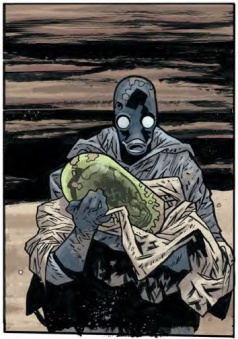
Varvara
Demon
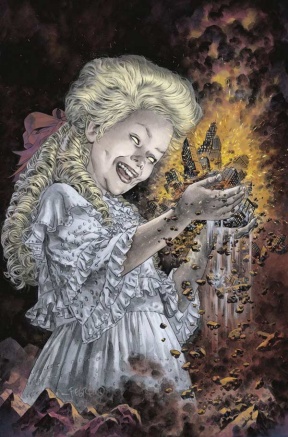
Scott: She’s not on the first issue cover for nothing. Varvara is the ultimate example of a character introduced in a small way who grew more and more important. Frankly, artists kept asking to draw her. She was introduced, of course, in “1946,” in a story by Mike, Josh Dysart, and Paul Azaceta. We didn’t know how much her role would expand, but then John started using her beyond the ‘historical’ stories. We never guessed she’d be this important when we first introduced her. It reflects some of what I was saying before about how this is all done. Mike had a plan from the beginning, and we’ve never abandoned that plan, but the line of book wouldn’t be as good as it is if we hadn’t given ourselves so much room to be flexible. Varvara fulfilled a need we didn’t know we had. Mike and Josh created her well, and John folded her into the present day story in a way that made a lot of things possible. I don’t know that it could’ve worked as well if we’d planned it.
Mark: She’s another character with a weight of history to her, but her history is much more personal. There’s a temptation with epic stories to go bigger and bigger—the city is doomed, then the world, then the universe… In “Hell on Earth” we got more and more Ogdru Hem until finally one of the Ogdru Jahad arrived. How do you top something like that? At a certain point going bigger becomes meaningless.
I find it more interesting to go personal. While Satan is certainly a notorious and evocative character, in theory, I think he’s far more interesting dead than alive. In his place we have Varvara. Unlike the other great evils, she’s not merely a force of nature. She’s complicated, she has desires, she’s curious, and even longs for a companion like she once had in Trevor. She can even be genuinely sympathetic at times.
Scott: It’s true, at a certain point going bigger would become meaningless. That won’t happen here. Going big and going personal is how Mike looks at his characters. Their own mythic elements mean the personal is apocalyptic. I like the villains we’ve cooked up over the years, especially Varvara. While I believe Strobl’s motivations are unique, or those of some of our other doomsayers, they’re still people saying, ‘I’ll help end the world, isn’t that great?’ Varvara’s motivations are different, and the desire that drives her in “The Devil You Know” is personal, yet mythic, and helps us get past the obstacle you bring up, which is that going bigger than an Ogdru Jahad is impossible.
When we were plotting “Hell on Earth,” I’d suggest bringing an Ogdru Jahad to Earth. The initial reaction was, ‘We can’t do that.’ And I knew why we ‘couldn’t’—it was too big. But that was the reason I felt we had to. Give ourselves a problem so big there’s no way to solve it… then solve it. And John did so brilliantly, meaningfully, personally, by making it the ultimate resolution of Johann. And you know, if we’d done that and thought, ‘Shit, we have nowhere to go from here…’ Then I think we would have ended the series after “Hell on Earth.” But fortunately, we do have somewhere to go. And the complexity that John set up within Varvara’s personality is a big part of why it’ll work.
“B.P.R.D. The Devil You Know” #1 comes out next week. Don’t miss it. If you missed it yesterday, Mike Mignola did an interview with Nerdist about it and showed off a few preview pages too.
Written by Mike Mignola and Scott Allie
Illustrated by Laurence Campbell
Colored by Dave Stewart
Lettered by Clem RobinsBefore they were vanquished by the BPRD, Lovecraftian monsters created a Hell on Earth. Now Liz Sherman leads a crew through monster-infested ruins on the most important rescue mission of her life. As society tries to rebuild, strange cults vie for influence, and a demon emerges to lead the way…

